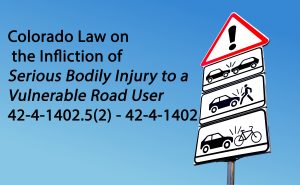Colorado Law – Infliction of Serious Bodily Injury to a Vulnerable Road User 42-4-1402.5(2) – 42-4-1402
 By H. Michael Steinberg – Colorado Criminal Defense Lawyer
By H. Michael Steinberg – Colorado Criminal Defense Lawyer
Introduction
Quietly, in 2019, the Colorado State Legislature enacted a new law enhancing the penalty for automobile/pedestrian collisions. The law specifically identifies certain “vulnerable road users” and substantially enhances the penalty in such accidents, providing new protections for road users identified as “vulnerable.”
The law – Senate Bill 19-175 – was signed by Colorado Governor Jared Polis on May 29, 2019, and immediately went into effect.
The new charge, an enhanced form of careless driving, reads as follows:
Defendant unlawfully drove a motor vehicle in a careless and imprudent manner without due regard for the width, grade, curves, corners, traffic, and use of the streets or highways and all other attendant circumstances and the defendant’s actions were the proximate cause of serious bodily injury to a vulnerable road user; in violation of sections 42-4-1402.5(2) and 42-4-1402, C.R.S.
The summons (ticket) must include both sections (42-4-1402.5(2) and 42-4-1402) to fall within the purview of the new statute.
While the law primarily seems to be directed at automobile/bicyclist collisions, it identifies several other vulnerable road users to include:
(a) A pedestrian;
(b) A person engaged in work upon a roadway or upon utility facilities along a roadway;
(c) A person providing emergency services within a right-of-way;
(d) A peace officer who is outside a motor vehicle and performing the peace officer’s
duties in a right-of-way;
(e) A person riding or leading an animal; or(f) A person lawfully using any of the following on a public right-of-way, crosswalk, or shoulder of the roadway:
(I) A bicycle, electrical assisted bicycle, tricycle, or other pedal-powered vehicle;
(II) A farm tractor or similar vehicle designed primarily for farm use;
(III) A skateboard;
(IV) Roller skates;
(V) In-line skates;
(VI) A scooter;
(VII) A moped;
(VIII) A motorcycle;
(IX) An off-highway vehicle;
(X) An animal-drawn, wheeled vehicle;
(XI) Farm equipment;
(XII) A sled;
(XIII) An electric personal assistive mobility device;
(XIV) A wheelchair;
(XV) A baby stroller; or
(XVI) A non- motorized pull wagon.
An important definition related to the law is the definition of serious bodily injury:
Colorado law C.R.S. 42-2-1601 (4)(b), defines Serious Bodily Injury as:
… an “injury that involves, either at the time of the actual injury or at a later time, a substantial risk of death, a substantial risk of serious permanent disfigurement, or a substantial risk of protracted loss or impairment of the function of any part or organ of the body, or breaks, fractures, or burns of the second or third degree.”
The Infliction of Serious Bodily Injury to a Vulnerable Road User 42-4-1402.5(2) – 42-4-1402 – Penalties
The enhanced penalties as outlined in the law are the result of the creation of a new class 1 traffic misdemeanor – C.R.S. 42-4-1402.5, which, as noted, apply to a driver who is charged under the law.
A person convicted of careless driving causing serious bodily injury to a vulnerable road user is subject to the following penalties:
12 points assessed against the driver’s state-issued license- which results in the loss of a driver’s license for most Colorado drivers.
The requirement of a driver improvement course.
Useful public service not to exceed 320 hours.
The payment of restitution.
Up to 12 months in jail and/or a $1,000 fine.
For some background information – the following information is provided:
Misdemeanor traffic offenses in Colorado are separated into Class 1 misdemeanor traffic offenses and Class 2 misdemeanor traffic offenses.
Persons convicted of a Class 1 misdemeanor traffic offense are subject to a minimum sentence of 10 days in jail or a $300 fine, or both, and a maximum sentence of one year in jail or a $1,000 fine, or both.
Persons convicted of a Class 2 misdemeanor traffic offense are subject to a minimum sentence of 10 days in jail or a $150 fine, or both, and a maximum sentence of 90 days in jail or a $300 fine, or both.
A Bill is Signed into Law
At the signing ceremony, Colorado’s Governor Polis of course painted the law in a predictably one-sided way.
He stated:
“We want Colorado to be safe for people to get around,”
…“Whether that means biking to work, whether it means walking to work, whether it means you need a wheelchair to get around, we need to make sure that we’re a safe state that gives people those choices.”
Like all sound bites, the impact of the law is far broader than represented and never as simple as it would seem.
A Closer Look at Mental States and Colorado Criminal Law
Typically criminal culpability focuses primarily on the mental state of the person involved in a serious accident then the impact of their crimes follows, and not the other way around.
Careless driving, as I have described in other articles, requires that the accused have the mental state of simple negligence– the lowest mens rea or criminal mental state necessary to prove the commission of a crime.
Careless driving is a kind of negligence “catch-all” traffic offense for the actions of a driver that are not perfectly performed under Colorado’s traffic laws. A traffic officer’s favorite charge because of the blurred lines in the elements of the charge, careless driving has always been a four-point penalty assessment (as assessed against a defendant’s driver’s license).
When you compare the four-point careless driving charge to reckless driving – an eight-point – habitual traffic offender crime this makes sense.
Reckless Driving as Compared to Careless Driving
Reckless Driving: Any person who drives any motor vehicle, bicycle, or motorized bicycle in such a manner as to indicate either a wanton or willful disregard for the safety of persons or property is guilty of reckless driving .
Careless driving: – Defendant unlawfully drove a motor vehicle in a careless and imprudent manner without due regard for the width, grade, curves, corners, traffic, and use of the streets or highways and all other attendant circumstances
Even the very serious crime of reckless driving requires a mental state of recklessness – the wanton or willful disregard for the safety of persons or property – as the mental state that must be proven by the State. Notably, even a reckless driving conviction at eight points, will, alone, NOT result in the revocation of an adult driver’s license.
With the passage of this law, if a driver is convicted of this class 1 misdemeanor traffic crime (even with a pristine traffic record) that driver will lose his or her right to drive. The privilege to drive will be rescinded, not based on their mental state as a driver, but based almost exclusively on the injuries sustained by the person (pedestrian/ “vulnerable road user”) injured in the accident.
It is obvious that the new law was passed with the best of intentions, however, it is unfortunate that the law leaves no room for a consideration of the driver’s mental state at the time of the accident before removing the driver’s right to drive.
The Doctrine of Comparative Negligence Has No Application is Not a Defense Under Colorado’s Criminal Code
Colorado’s criminal codes and the criminal codes of other states do not provide for “comparative negligence,” – a civil legal theory that balances the actions of one party as compared to that of the other.
Comparative negligence allows a judge or jury, whoever is the factfinder at trial, to weigh the reasons behind the accident and to take into consideration the relative fault of the parties, if that fault is shared.
Unfortunately, criminal law provides for a zero-sum game – the accused is either guilty or innocent, the crime is either proven or it isn’t.
Therefore, a skateboarder/bicyclist/walking pedestrian struck by the side of the road in the dead of night – in pitch black – wearing non-reflective clothing will always be the victim of the negligence of the driver of the car- no matter how cautious the driver was being.
In the field of criminal law, there is simply no vehicle for comparing the actions or inactions of the parties to determine relative fault as exists in civil lawsuits.
While an experienced criminal defense lawyer could argue that the victim’s actions caused or contributed to their injuries hoping the jury will acquit the defendant, that is a very risky strategy at trial. The law, as it existed before these changes, allowed for a more reasoned approach to a resolution of these cases and, as a result of the enactment of the law, the inherent risks of trial have been greatly enhanced.
Every case, if there is a conviction, irrespective of the relative negligence of the parties, will result in one harsh punishment. There is no allowance for any kind of comparison or weighing of the negligence of the parties that may have been present on the part of the victim.
One state, the state of Wisconsin, actually spells out the cold, hard impact of the law in this area in the following clear and precise jury instruction on this stark policy:
Summary and Conclusion – the Infliction of Serious Bodily Injury to a Vulnerable Road User C.R.S. 42-4-1402.5(2) – 42-4-1402 – Some Thoughts
Finally, as always, the best intentions of the Colorado State Legislature underlying this law will be left to the judgment of the (sometimes inexperienced) district attorneys assigned to these cases. Their decisions will no doubt have a massive impact on the lives of those unfortunate enough to find themselves across the table charged with the new law in our states’ county criminal courts.
February 6, 2021
If you found any information I have provided on this web page article helpful please share with others over social media so they may also find it. Thank you.
Never stop fighting – never stop believing in yourself and your right to due process of law.
 ABOUT THE AUTHOR: H. Michael Steinberg – Email The Author at hmsteinberg@hotmail.com – A Denver Colorado Criminal Defense Lawyer – or call his office at 303-627-7777 during business hours – or call his cell if you cannot wait and need his immediate assistance – 720-220-2277. Attorney H. Michael Steinberg is passionate about criminal defense. His extensive knowledge of Colorado Criminal Law and his 42 plus years of experience in the courtrooms of Colorado may give him the edge you need to properly defend your case.
ABOUT THE AUTHOR: H. Michael Steinberg – Email The Author at hmsteinberg@hotmail.com – A Denver Colorado Criminal Defense Lawyer – or call his office at 303-627-7777 during business hours – or call his cell if you cannot wait and need his immediate assistance – 720-220-2277. Attorney H. Michael Steinberg is passionate about criminal defense. His extensive knowledge of Colorado Criminal Law and his 42 plus years of experience in the courtrooms of Colorado may give him the edge you need to properly defend your case.
You must make a responsible choice for a Colorado Criminal Defense Lawyer – we encourage you to look at our firm. Over the last 35 plus years, H. Michael has studied and written about nearly every area of criminal law, procedure, trial, and courtroom practice. He is passionate about getting the best result in each of the cases he defends. By studying the law and writing these articles, he hopes to not only master the law but help you in your understanding of your case in some small way.
 Colorado Criminal Lawyer Blog
Colorado Criminal Lawyer Blog

